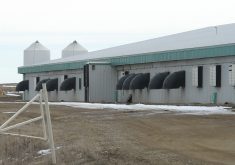Soil tests in Western Canada indicate that crop-available phosphorus is in short supply.
Fifty-nine percent of fields in Alberta don’t have enough to meet crop needs, 73 percent in Manitoba and 86 percent in Saskatchewan.
Most producers apply phosphorus fertilizer in the spring along with their seed.
“It needs to be there when the plants need it,” said Geza Racz of the University of Manitoba.
“If it is there, it is a signal to the plants to go ahead with growth.… I think a lot of people are missing out on several bushels per acre by not handling their P properly.”
Read Also

Bunge sells assets per merger approval
Bunge has sold five western Canadian elevators as required under the federal approval for its merger with Viterra.
He told producers attending the Agri-trend Farm Forum in Saskatoon in November that they need to consider the way their crops use the nutrients and meet the plants’ needs.
Phosphorus isn’t mobile in soil, so it is critical to place it close to the growing crop.
“You paid to put it in the field this year, yet the plant can’t access it. Then your investment won’t be paying you any dividends this year,” he said.
“It will be there for next season, but that isn’t what you intended. You wanted it to deliver with this crop.”
Plants access 10 to 35 percent of phosphorus in the year of application.
Phosphorus is the one major nutrient that is nearly 100 percent efficient in the long term because little is lost to anything other than plant growth.
“But how much do you have?” he said.
“Are your fields some of those with enough? Or are they running short? If you apply some every year, you likely have some surplus out there. If you skip a year once in while, maybe you have a medium amount. If you grew some big crops and applied some a few years ago, you might be in trouble.”
Racz said soil testing is the place to start this spring.
“Most prairie soils that test low in available P will do well with 30 pounds per acre, and economic benefits are easily found.”
He said adding amounts greater than what the crop will remove could be a good decision for tax reasons because it builds up the phosphorus bank in the soil.
“If you test medium, then match (crop) removal amounts,” he said.
“If you have high amounts, then match removal or add just a small amount to the starter blend to ensure it is there with the seed early in the season.”
Placing phosphorus with large amounts of urea can delay seedlings’ access to the nutrient. The greater the delay the lower the yield, especially when soil is cold and wet.
El Nino and a wet freeze-up seem to be indicating that will be the case next spring, which will make nutrient placement critical.
“The P needs to get into the plant in the seedling stages. I can’t say this enough,” Racz said.
He said research has found that narrow bands of highly concentrated material kept phosphorus out of the roots in early plant stages. It also wasn’t available when producers stretched it over two or three inches, because now it was too far away from the roots.
Jarrett Chambers of ATP Nutrition said phosphorus is most important within one to two millimetres of the root.
“There has to be a lot of P available in the root zone,” he said.
“Ten to 35 percent P efficiency in the first season is based on good availability. Flax or canola will reach 20 percent due to roots exploring the soil for P.”
Racz said the solution is to add 10 to 15 pounds of phosphorus with the seed and place the balance with the remaining fertilizer for later or next season’s use.
“Research in Australia showed that five pounds per acre applied as a seed coating can be very effective,” he said.
Chambers said getting the nutrient into the zone is so important that highly concentrated amounts of fertilizer, even placed in the seed row on narrow row spacings, can cause the space between droplets or prills to be too far apart to make them available to plants early in the season.
Farmers might want to use a product with a lower concentration of phosphorus to ensure more of it is available to the plant in its earliest stages, he added.
Terry Aberhart, an agronomist who farms near Langenburg, Sask., said adding a seed primer to the mix, along with a low analysis blend of phosphorus, can improve the availability in the seed row.
“A primer and an 11-52-0 side banded will work,” he said.
“Or for a bigger result, a 16-20-0- 13 seed-placed and a primer on the seed and then sideband the rest in.”
Racz said plants use the ortho form of phosphorus. Polyphosphates are made up of orthophosphate molecules stuck end to end.
“These two forms are equally useful in Western Canada,” he said.
“Yes, (polyphosphates) break down so quickly in our soils that there is no difference.”
Liquid orthophosphate trials resulted in yield increases in soil with 60 percent calcium carbonate, such as some found in Australia.
“In that high pH, highly carbonated soil, there is a case for it (orthophosphates),” Racz said.
“Liquid versus granular? Liquid is associated with the ortho. But that isn’t the bigger issue. The best one is the cheapest one per acre that meets your farming system’s needs.… There are a lot of ways to do this. It is based on your equipment design and your logistics issues at seeding.
“But it might be important enough to make some machine changes.… It only takes a few bushels an acre, a little earlier crop or one that is just a little more even at maturity to pay for the right setup in the first year or two.…
“And these are the times to do it, when the prices are up and higher yields deliver the biggest financial benefits from your investment.”














